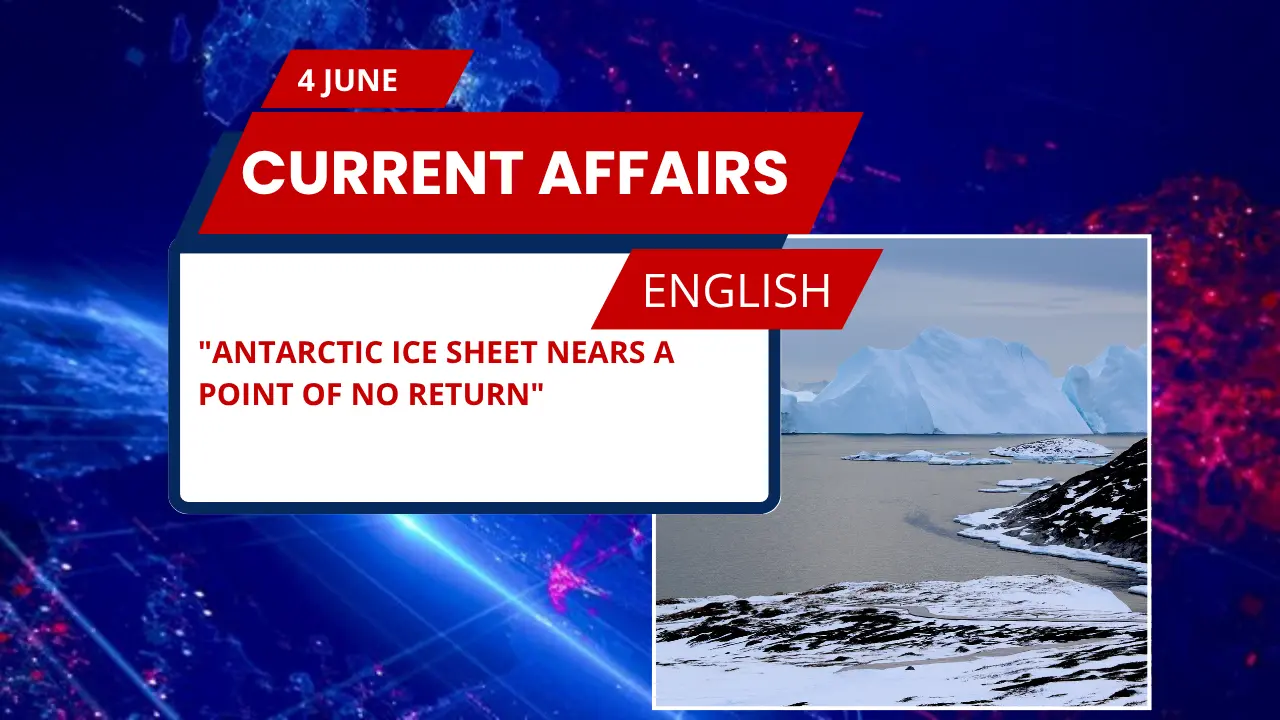
Key Points for SSC & Other Government Exams
- Tipping Point: Antarctic Ice Sheet is nearing an irreversible melting threshold.
- Hysteresis Effect: Ice continues melting even after temperatures fall.
- Impact: Possible sea-level rise up to 4 meters.
- Cause: Ocean temperature rise of just 0.25°C can cause major damage.
- Research Institutes: NORCE Research, Northumbria University, and Potsdam University.
- Timeframe: Ice loss recorded over just 40 years, though ice sheets usually respond over thousands of years.
- Consequence: Coastal cities face catastrophic flooding.
- Solution: Immediate reduction in greenhouse gas emissions needed.
Antarctic Ice Sheet Nears Tipping Point: A Climate Alarm
Recent scientific findings reveal that the Antarctic Ice Sheet is dangerously close to crossing a tipping point beyond which the ice could continue to melt regardless of future cooling. This process, called hysteresis, makes the situation extremely concerning as it means that the damage may become irreversible.
What is Hysteresis in Ice Sheets?
Hysteresis is a phenomenon where a system does not return to its original state even after the conditions that caused the change are reversed. In this case, once the ice sheet starts to melt past a critical temperature threshold, it continues melting, even if global warming is stopped.
Who Conducted the Study?
The research was conducted by:
- NORCE Research (Norway)
- Northumbria University (UK)
- Potsdam Institute for Climate Impact Research (Germany)
They used computer models simulating ice sheet behaviour over the last 800,000 years to understand how it might react in the future.
The Role of Ocean Warming
One of the most critical findings was that even a 0.25°C rise in ocean temperature can result in the Antarctic Ice Sheet melting, causing a sea-level rise of 4 metres. This would submerge major coastal cities, impact ecosystems, and cause economic devastation.
Why This is Urgent
While ice sheets typically respond slowly over thousands of years, the current melting is observed over just four decades. This rapid change is unusual and alarming, making predictions difficult and action urgent.
What Can Be Done?
Researchers emphasize that urgent climate action—especially reducing greenhouse gas emissions—could still help slow down or prevent further melting. The window for action is closing fast, so immediate global cooperation and policy change are necessary.
Future Outlook
If the tipping point is crossed, it may take thousands of years under pre-industrial temperature levels to restore the ice sheet. This underlines the long-term consequences of short-term inaction.
Exam Special: Important Information About Involved Institutions
Potsdam Institute for Climate Impact Research (PIK), Germany
- Founded: 1992
- Location: Potsdam, Brandenburg, Germany
- Focus: Climate science, Earth system analysis, sustainability
Northumbria University, UK
- Location: Newcastle upon Tyne, England
- Established: 1969 (as a university)
- Known For: Arctic and Antarctic climate research
NORCE Research, Norway
- Location: Bergen, Norway
- Fields: Energy, Climate, Environment, Society
- Goal: Applied interdisciplinary research for societal solutions
MCQs Based on This Topic
Q1. What is the term used to describe the process where a system doesn’t return to its original state even after conditions change?
A. Entropy
B. Regression
C. Hysteresis
D. Inertia
Answer: C. Hysteresis
Q2. According to recent studies, how much can sea levels rise if the Antarctic Ice Sheet continues to melt?
A. 1 metre
B. 2 metres
C. 3 metres
D. 4 metres
Answer: D. 4 metres
Q3. Which of the following institutions did not participate in the Antarctic Ice Sheet study?
A. NORCE Research
B. Northumbria University
C. Indian Institute of Science
D. Potsdam University
Answer: C. Indian Institute of Science
Q4. What minimum rise in ocean temperature is enough to accelerate the Antarctic Ice Sheet melting process?
A. 0.10°C
B. 0.25°C
C. 1.0°C
D. 2.5°C
Answer: B. 0.25°C
Q5. What is the observed timeframe for current ice sheet melting?
A. 400 years
B. 80 years
C. 40 years
D. 100 years
Answer: C. 40 years






